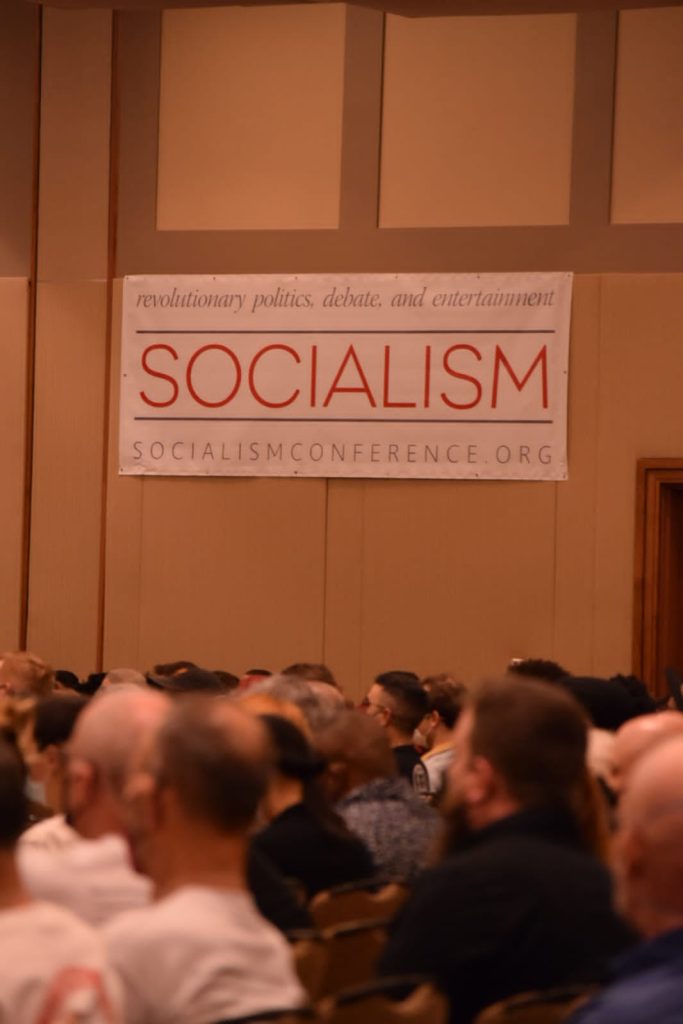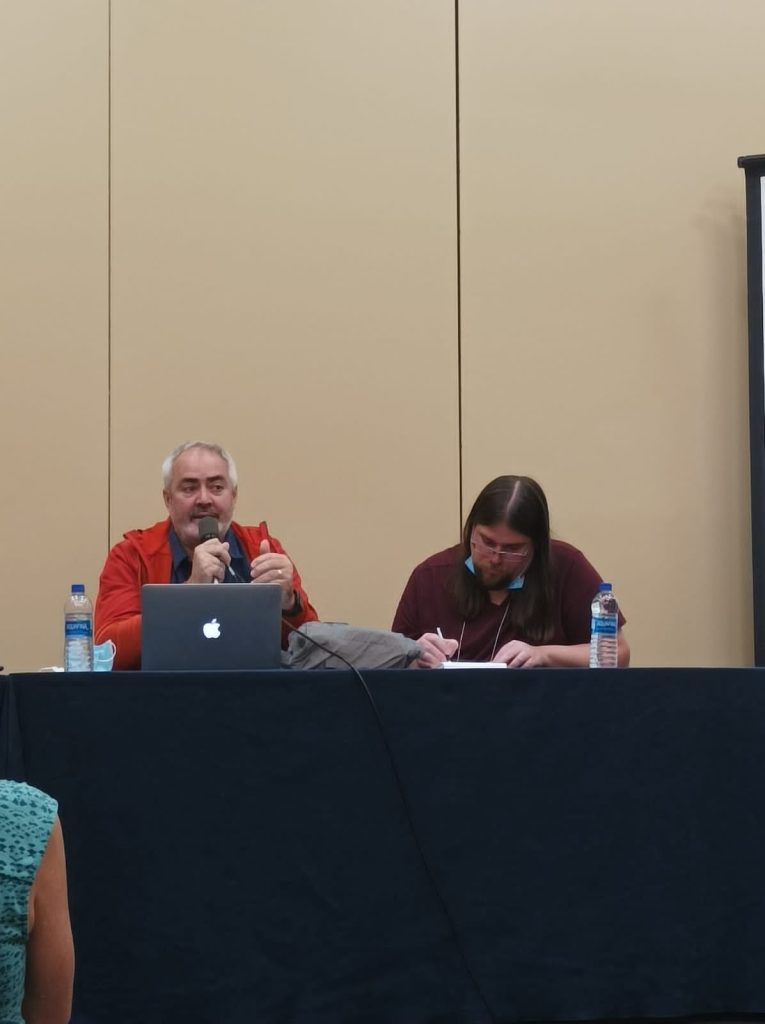Por: Luis Meiners
La Conferencia Socialism 2022 se realizó del 2 al 5 de septiembre en Chicago. Esta edición marcó el regreso a la presencialidad luego de la pandemia. Más de 1500 socialistas de todo Estados Unidos se encontraron para debatir y organizarse. Socialism 2022 fue una muestra de la energía que tiene el movimiento socialista y también de sus desafíos y debates estratégicos.
La conferencia Socialism es un importante hito para la izquierda en EEUU desde hace décadas. Durante la mayor parte de su historia tenía entre sus principales impulsores a la ISO, pero desde la disolución de esa organización en 2019 su continuidad ha sido garantizada por varias organizaciones, entre las que se destaca el esfuerzo de la editorial Haymarket. El hecho de mantener en pie este espacio de encuentro y debate es en sí mismo un punto muy positivo.

La coyuntura
El contexto político es claramente diferente al de la última edición presencial de la conferencia en 2019. Aquella estuvo marcada por el clima de resistencia y lucha contra Trump y la expectativa por la campaña de Sanders de 2020, con un DSA que venía creciendo muy rápidamente. La actual estuvo marcada por la experiencia del ciclo electoral 2020 y la rebelión anti-racista, ambos procesos que marcaron los límites de la orientación estratégica dominante dentro del DSA. Esto ha generado una crisis en esa organización, cuya dirección se ha movido significativamente a la derecha. La adaptación de Sanders y otras figuras electorales progresistas al gobierno de Biden y el Partido Demócrata, indican que no hay muchas perspectivas en el plano electoral. Esto genera un vacío de orientación para el DSA y una sangría de participación en su vida interna, profundizando las tendencias burocráticas.
Por otro lado, tal como se demostró en la conferencia, un importante activismo surgió de la rebelión de 2020. A esto se suma tambien una gran cantidad de activistas movilizados por la lucha en defensa del derecho al aborto y los derechos sexuales y reproductivos, así como los derechos de las personas trans y todas las disidencias que estan bajo ataque por la derecha reaccionaria en varias partes del pais. Finalmente, está también el resurgimiento del activismo en la clase trabajadora que tiene como hitos las campañas de sindicalización en Amazon y Starbucks, pero se extiende más allá.
La conferencia y algunos debates
Este momento político y los debates estratégicos que lo acompañan que se vió reflejado en la conferencia. En primer lugar, en la propia composición de la conferencia, multi-racial y con un importante peso de juventud. Según los organizadores, alrededor del 75% de los participantes asistían a Socialism por primera vez, lo cual puede interpretarse como indicador de la presencia del activismo surgido en el último periodo.
En segundo lugar, se reflejó en los propios paneles. Un aspecto de esto fue la importante presencia de paneles que podemos identificar a grandes rasgos con perspectivas abolicionistas. Gran parte de estos se enfocaron en la lucha contra el racismo y contra la policía y las instituciones del aparato represivo. Muchos de estos paneles estuvieron organizados por agrupaciones surgidas al calor de las luchas contra el racismo sistémico que han sido uno de los aspectos fundamentales de las luchas sociales de la última década. También tuvieron una importante presencia las perspectivas feministas socialistas, junto con reuniones para organizar la lucha en defensa de los derechos reproductivos y sexuales.
Otra parte importante de los paneles reflejaba los debates en torno a la orientación del DSA, el balance del último periodo y las tareas de la izquierda. Esto incluyó paneles organizados por sectores de la dirección del DSA que profundizaban una orientación hacia la derecha, defendiendo la necesidad de votar a los demócratas frente a la amenaza reaccionaria y “fascista” de los republicanos. Un aspecto interesante fue que ese tipo de argumentos desarrollado por algunos panelistas encontró resistencia entre los asistentes, y se dieron importantes debates, mostrando que una parte importante del público estaba a la izquierda del panel.
En cuanto a los debates sobre las tareas de la izquierda es importante destacar la participación de Tempest, publicación y proyecto de organización socialista del cual participo. Desde distintos paneles y debates, Tempest desarrolló una perspectiva socialista revolucionaria, y una orientación centrada en las luchas desde abajo, y la necesidad de organización revolucionaria. Sostuvo un claro contrapunto con las miradas electoralistas y de seguidismo al partido Demócrata, explicando el papel histórico de ese partido y defendiendo la independencia de clase. Invitando, al mismo tiempo, a reflexionar sobre los caminos para construir una organización socialista que esté a la altura de los desafíos del presente, evitando tanto el reformismo oportunista como el sectarismo.
Debates internacionales y la participación de la LIS
Otros debates que tuvieron expresión en la conferencia giraron en torno a temas internacionales. Partiendo de una generalizada oposición al imperialismo estadounidense y la OTAN, hubo importantes debates con sectores campistas. La invasión rusa a Ucrania fue uno de los puntos álgidos de estos debates, con algunas expresiones minoritarias de apoyo a Rusia e importantes expresiones de solidaridad con la resistencia del pueblo ucraniano. También hubo debates sobre China, y relatos de las luchas de la clase trabajadora dentro de la potencia emergente. Finalmente, en línea con su reciente adhesión al Foro de Sao Paulo, el comité internacional del DSA organizó un panel centrado en el apoyo a Lula y los “progresismos” latinoamericanos, mostrando que su orientación reformista y posibilista conduce al apoyo a fuerzas y gobiernos que frustraron las energías de cambio en el continente latinoamericano.
La Liga Internacional Socialista estuvo presente en el panel “La organización revolucionaria hoy: una perspectiva internacional” auspiciado por Tempest. Alejandro Bodart coordinador de la LIS y del MST de Argentina, habló en este panel del cual también participaron Natalia Tylim de Tempest, y Andreu Coll de Anticapitalistas del Estado Español y el Secretariado Unificado. Este panel buscaba abordar las oportunidades y desafíos para la construcción de organizaciones revolucionarias en un periodo marcado por la crisis del 2008, la polarización y las rebeliones, dentro del cual también se dieron importantes crisis en distintas organizaciones revolucionarias. Alejandro marcó la importancia clave de la organización internacional, subrayando la imposibilidad de superar los problemas y desafíos de la organización revolucionaria a escala nacional. En este sentido, destacó la necesidad de construir una internacional que pueda unir distintas tradiciones del movimiento revolucionario en base a un programa revolucionario, con una estrategia insurreccional, sin sectarismo ni oportunismo donde se pueda convivir con diferencias y debates pero al mismo tiempo tenga como norte intervenir en la realidad, no solo hacer propaganda. También la necesidad de hacer un balance de la intervención de la izquierda revolucionaria en el último periodo, particularmente ante los nuevos fenómenos de la realidad como los partidos amplios que surgieron al calor de la crisis. Un sector de la izquierda actuó con sectarismo, se negó a intervenir. Mientras otro actuó de manera oportunista, llegando incluso a disolverse en esos partidos, y abandonar la estrategia de construir un partido revolucionario. Estos errores retrasaron la construcción de la alternativa revolucionaria. Frente a esta disyuntiva, Alejandro marcó una posición distinta, partiendo de ver la necesidad de intervenir en esos procesos, pero sin abandonar la estrategia de la construcción propia, revolucionaria, sabiendo que todos estos partidos tenían fecha de vencimiento ya que los reformistas más temprano que tarde iban a integrarse al régimen. Agregó, además, que este tipo de formaciones no está en ascenso en este momento. Finalmente, llamó a la unidad de quienes comparten estas posiciones.


Hacia adelante
De conjunto, la conferencia Socialism 2022 demostró que hay una importante energía en el movimiento socialista en EEUU. Nuevas camadas de activistas siguen acercándose, y traen consigo nuevas perspectivas y debates. Al mismo tiempo, pudo verse que existen importantes debates en torno a la orientación y las tareas de la izquierda socialista en este periodo.
En este marco, el desafío que sigue pendiente es el de construir una organización revolucionaria que pueda darle una expresión organizativa a este movimiento, y que permita dar a fondo todos los debates necesarios. Una organización que pueda evitar que la fuerza y la rebeldía que expresan los miles de activistas no se disipe. Esta es la tarea clave del momento.




